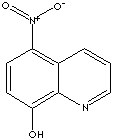PRODUCT IDENTIFICATION

H.S. CODE
TOXICITY
CLASSIFICATION
PHYSICAL AND CHEMICAL PROPERTIES
REFRACTIVE INDEX
NFPA RATINGS
AUTOIGNITION
FLASH POINT
APPLICATIONS
Oxyquinoline, hydroxyquinoline at 8- position, is used as a bacteriostatic and fungistatic agent. It is used in preparing antiseptics, deodorants, antiperspirants, and fungicides. The sulfate salt of 8-hydroxyquinoline is used as a complexing agent for pharmaceuticals. 8-Quinolinol is used as a precipitating agent or chelating agent to separate metals. It is also used in formulating anti-dandruff agents for shampoo.
Chlorquinaldol, 5,7-dichloro-2-methyl-8-hydroxyquinoline, has antibacterial, antifungal and amoebicidal activity with antieczematic and antipruritic properties; used topically in the treatment of cutaneous and vaginal infections. It is a similar agent to clioquinol. Clioquinol is one of the halogenated 8-quinolinols which are antibacterial, intestinal antiamebic, and vaginal trichomonacide agents. They are derived from 8-hydroxyquinoline, an antiseptic agent with mild fungistatic, bacteriostatic, anthelmintic, and amebicidal action.
Clioquinol, iodochlorohydroxyquinoline, is an antifungal with antieczematic and antipruritic properties. Clioquinol topical preparations are used to treat skin infections. It was administered orally in the treatment of amebic dysentery. The oral preparation is banned worldwide due to associated subacute myelo-optic neuropathy.
Nitroxoline (5-Nitro-8-Hydroxyquinoline) pharmacological actions include urinary anti-infective, antifungal and disinfectants.APPEARANCE
CONTENT
99.0% min
MELTING POINT
0.5% max
0.2% max
0.1% max
0.6% max
20ppm max
20kgs
in fiber drum
PRICE INFORMATION